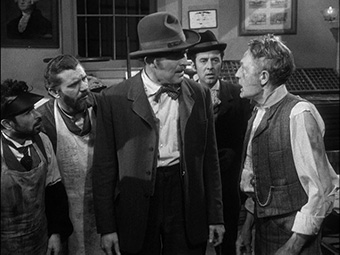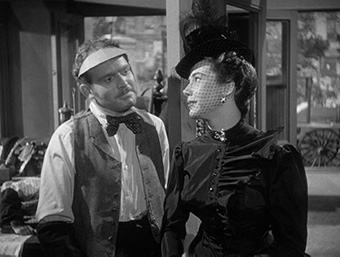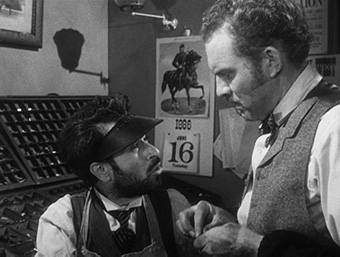| |
"It's tragic to remain a living legend, Mr. Mergenthaler. People only respect the dead. Often I feel guilty for taking such a long time to die. But I shall not die until I am ready to forsake Park Row, which has already forsaken me." |
| |
Journalist Josia Davenport in Park Row |
| |
"In this film I have revealed my point of view on the press. I detest seeing newspapers judge and condemn men, without any motive but to use their power to destroy. The fascists do that. I have put in much of myself. It is also one of the first works where I have been truly aware of the technique, of the camera work, of the superiority of long shots on the montage effects. And for all that it was filmed in ten days." |
| |
Writer-director Samuel Fuller |
Watch the opening ten minutes only of Park Row, Sam Fuller's dynamite 1952 newspaper drama set in 1886 New York, and you're presented with what initially appears to be a blatant contradiction, as a title sequence that sings a hymn to American journalism is followed sharply by an attack on the immorality of the yellow press. But the assault in question is launched by fiercely principled journalist Phineas Mitchell (Gene Evans), who accuses The Star – the paper for which he works – of sending an innocent man to the gallows in their ruthless pursuit of a headline. So disgusted is he with the actions of his employers that he nails a sign on the victim's grave accusing The Star of murder. A short while later, the paper's black widow of an editor, Charity Hackett (an excellent Mary Welch), arrives at the bar in which the journalists congregate and demands to know who was responsible for this stunt. Mitchell owns up in a heartbeat and is dismissed on the spot. When his friend and colleague Jeff Hudson cheerfully defends him, he is fired too.

When Charity has departed, Mitchell recalls his long-held dream of running his own paper – The Globe – and bar regular Charles Leach responds by offering him funding and access to a printing press. Mitchell promptly recruits a number of his trusted associates and announces that their first edition will be published the following day. Hackett is initially dismissive of Mitchell's efforts, but Mitchell's innovation and enthusiasm quickly makes The Globe a serious threat to The Star's circulation figures.
As both a writer and director, Fuller grabs us from the opening frames through his seductive use of moving camera and the sheer dynamism of the dialogue and character interplay. If the title sequence pullback to the statue of Johannes Gutenberg and the subsequent high-angle tracking shots of the street don't grab you then the opening bar room scene definitely should. As barmaid Jenny reels off a list of available drinks at a dizzying speed (which proves to be a set-up for an old gag), most of the key players are introduced and briefly profiled, their personalities, careers and even life-views established in a few smartly written and performed seconds of screen time apiece. With its coordinated character interaction and economically inventive dialogue, the banter has the wit, polish and energy of well-rehearsed theatre, but is rendered cinematically enthralling by Jack Russell's roving camera, which moves between the patrons like a curious eavesdropper with an ear for conversation. And everyone here makes an instant impression, from ageing, easy-going journalist and philosopher Josiah Davenport (a lovely turn from Herbert Heyes) to unemployed cartoonist Tom Guest, lightning-fast typesetter Mr. Angelo, and enthusiastic young ragamuffin Rusty. And let's not forget Mitchell, a hard-boiled, cigar-chewing and passionate journalist whom actor Gene Evans has clearly based on Fuller himself.

It's a captivating short-cut to character establishment that enables Fuller to kick off the story at a breathless pace and be confident that his audience will never lose track of just who is who. It's also here that the foundations are laid for just about everything that follows, sometimes with such sleight-of-hand economy that the significance of memorable but seemingly throwaway moments does not become clear until later in the film. Thus, the fame-seeking Steve, who takes the journalists' joshing about jumping from the Brooklyn Bridge seriously, becomes a key component of The Globe's first edition, while Tom's trick of drawing a face on a head of beer is later employed by Jenny to pass a secret message to Davenport. Even the decision to hire Tom proves to have specific narrative purpose, when his front page cartoon of Steve's jump and subsequent arrest (which Mitchell helps engineer in order to then campaign for his release) enables us to instantly recognise, even in wide shot, which paper everyone is reading as Hackett returns from her first sortie into enemy territory.
Park Row is the sort of story that Fuller always excelled at, a mythmaking tale of little guys battling against seemingly impossible odds with a heady mix of determination, guts, teamwork and imagination. Bold and inventive ways are found to overcome the obstacles thrown in their path, which increase in severity to the point where The Globe's fight for survival degenerates into all-out war. To this end, Fuller cheerfully adapts and borrows from historical fact, making The Globe the first newspaper to be sold on the street through newsstands and the first to feature different front pages on the same edition. It is also Mitchell and his colleagues who launch a campaign to raise funds for a base for the Statue of Liberty (this was actually the work of famed newspaper publisher Joseph Pulitzer), and the Globe staff includes a German named Ottmar Mergenthaler, who at just the right moment perfects an invention that Mitchell names the linotype. As anyone who knows their newspaper history will be aware, the linotype machine become the industry standard for newspaper type setting from the late 1800s onwards and was indeed invented by Ottmar Mergenthaler, but under the real world patronage of the Whitelaw Reid of the New York Tribune.
Fuller supercharges his narrative with the same ruthless energy and focus on character and narrative that characterised his previous war movies The Steel Helmet and Fixed Bayonets, as well as later classics like Shock Corridor and The Naked Kiss. Sentimentality has no place here – when a character that other films would have gone all weepy over is seriously injured, we hear about the incident rather than see it, and the person in question then drops out of the story. Even Mitchell and Hackett's developing attraction for each other proves something of an emotional minefield, being shackled with the dual threats of distrust and betrayal.

The film's fame as a richly cinematic work, one that was to prove a big influence on the developing camera style of a young Martin Scorsese, is clearly evident from the dynamic opening crane and track shots, but really hits home in the hyper-energised technical and emotional centrepiece, where the camera locks onto Mitchell as he races down Park Row and in and out of buildings, an insanely complex shot that even includes camera movements employed solely for dramatic punctuation. Even by today's standards it's an impressive achievement, but for low-budget, self-funded film from 1952, it's genuinely jaw-dropping.
As newspaper stories go, Park Row is the stylistic flipside of the seductive slow build of All the President's Men. It shouts where the later film whispers, but does so with an energy, eloquence, wit, and insider's knowledge – Fuller himself was a former copy boy turned journalist – that electrifies every scene. Fuller later cited this as his favourite of all his films; it's certainly one of his most passionately personal and everything a great American B-movie should be, and then some. Propelled by a sometimes breathless momentum and cinematic economy, it's as smart as it is sensational, and a superb showcase of Fuller's enviable talent as both a writer and director.
It's rare in these dual format days for Masters of Cinema to release a film on DVD only. This is almost never a reflection of the quality of the transfer, and we can only presume that the materials they had to work with here did not quite match the high standards they have set for their Blu-ray releases. Either way, you'll have no gripes with picture quality on this DVD, which boasts a clean, rock-solid 1.37:1 image with sublimely judged contrast and tonal range, and a crisp level of detail for an SD transfer.

The Dolby 2.0 mono track is clear, free of damage, and with only a trace of background hiss, though the soundtrack is rarely quiet enough for you to hear it even with the volume up.
English subtitles for the hearing impaired are provided, and there is also the option to play the film with the music and effects track only, a feature I've never really understood the appeal and purpose of, although it's good reference material if you're learning to mix film sound.
Bill Krohn on Park Row (21:04)
Cahiers du Cinema writer Bill Krohn provides his own reading of the film and some useful background on its production, with specific focus on the actors, Fuller's camera technique, cinematographer Jack Russell, and the film's anticipation of corporation-controlled tabloids.
Remarks by Christa Lang Fuller (2:20)
Sam Fuller's widow briefly talks about celebrated editor Arthur Brisbane, who gave Fuller his first newspaper job and on whom the character of Phineas Mitchell was based. The sound is far louder on this extra than on the main feature, so watch your volume when you start it.
Theatrical Trailer (2:01)
An appropriately headline-grabbing trailer that gives away a couple of plot twists if you're really paying attention.
Booklet
A particularly lovely MoC booklet that features a fascinating deconstruction of the film's technique and intent by Tag Gallagher, a superb extract from Fuller's memoir A Third Face in which the director looks back at the film and how he got to make it his way ("Fuck the entire studio system!"), a similarly captivating extract from an interview with Fuller conducted by Lee Server in his 1994 book Sam Fuller: Film is a Battleground, and another by Bill Krohn for Cahiers du cinéma in 1979. There's also a reproduction of a letter sent to Fuller by Irving Berlin, credits for the film, and a wonderful, title-free front cover consisting of a reprint of a page from The World newspaper (I couldn't quite make out the date on the PDF I was working from), one of whose bylines asks "Are you an anarchist?" like its looking for recruits.
No fence-sitting here – I'm a huge fan of the cinema of Sam Fuller and Park Row is one of my absolute favourites, a work born of passion for its subject and the unique storytelling potential of film. While we'd all love to see a pristine Blu-ray transfer, Masters of Cinema have still done the film proud on DVD. Highly recommended.
|